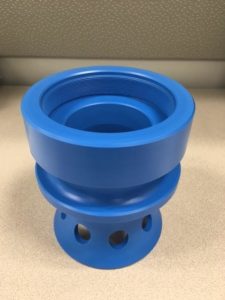
Engineering plastics offer excellent mechanical and/or thermal properties that meet the demanding needs of specialty industrial applications. But how do you know which material is right for your project? When you need an engineering plastics comparison, turn to the experts at Reading Plastic. Our decades of experience working with specialty plastics gives us hands-on knowledge into how these materials perform in a variety of settings, allowing us to recommend the perfect engineering plastic for your project.
What are the Benefits of Engineering Plastics?
Engineering plastics have better mechanical strength or thermal resistance than standard plastics, but are not as sophisticated and expensive as high temperature plastics. They can operate between 100°C and 150°C (212°F-302°F), have good chemical and wear resistance, and offer excellent machinability and dimensional stability. Other benefits include enhanced fire retardancy and the ability to hold tight tolerances and complex geometries.
Engineering Plastics Comparison: Top 5 Engineering Plastics
-
- POM – Commonly referred to as acetal, POM features high mechanical strength and rigidity, low moisture absorption, good sliding characteristics and excellent wear resistance. POM has good creep resistance and good impact strength, even at low temperatures, and excellent resilience/recovery elasticity. With good dimensional stability and fatigue strength, as well as excellent machining ability, POM is a highly versatile engineering plastic that is good for complex components.
- PET – Polyethylene terephthalate (PET) offers high strength, rigidity and hardness, good creep resistance, and hydrolysis resistance up to +70°C. PET has very low moisture absorption, outstanding sliding behavior and low wear (especially compared to POM in both damp and dry environments), and has good chemical resistance against acids. Its thermal properties support both a good temperature stability and dimensional stability. PET is perfect for applications that require complex parts, dimensional accuracy and surface quality.
- PBT – Polybutylene terephthalate (PBT) is characterized by high strength, rigidity, dimensional stability, and thermal deformation resistance. It has a low tendency to creep and has very good friction and wear properties. PBT has better impact strength than PET, especially at low temperatures, which makes it easier to modify with fibers. PBT has excellent resistance to chlorine and caustic cleaning solutions, making it the perfect choice for food industry applications. It also offers very good electrical characteristics, very low moisture absorption, and has a very low coefficient of thermal expansion.
- PA – Polyamide (PA) plastic is more commonly referred to as nylon. PA plastics are among the most important and useful plastics thanks to their outstanding wear resistance, very good temperature and impact properties, and good coefficient of friction. They also have low density, high thermal stability, and very good chemical resistance. Nylon is an especially oil resistance plastic, making it the ideal material to replace metal in automotive parts, industrial valves, and other industrial applications that require high strength, toughness and weight reduction. Nylon does have a propensity to absorb moisture, giving it a poorer dimensional stability than other engineering plastics.
- ABS – Acrylonitrile Butadiene Styrene (ABS) plastic is a bridge between general industrial plastics and engineering plastics. It is characterized by excellent toughness and impact strength even at low temperatures, high tensile strength and stiffness, and good machinability. It is inexpensive and has good chemical resistance along with gamma and x-ray resistance.
To learn more about engineering plastic comparisons and which material is right for your project, call Reading Plastic today at 610-926-3245.
